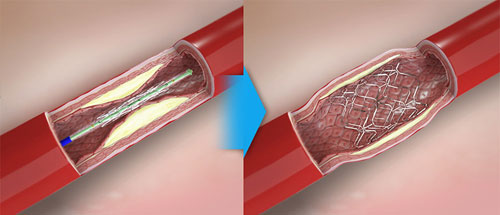Angioplasty is a medical procedure used to treat narrowing of the arteries. This is accomplished by inflating a small balloon inside the artery to increase the blood flow through the artery.
Stenting is a procedure involving the insertion of a metal tube (called a stent) that helps in the restoration of blood flow when there is narrowing in the arteries. A stent is an artificial device, a mesh-like metallic tube that has the ability to expand inside the blocked artery. To place a stent, a 2-3mm incision is made on the upper thigh. Through the incision, a catheter is introduced into the femoral artery and advanced to a point next to the narrowing and the stent is then deployed across the narrowed segment to cover the plaque causing the narrowing, and to open up the narrowing. The stent remains permanently in the artery where the inner lining of the artery will start to grow over this stent. The stent will almost always keep the artery open.

In craniocervical angioplasty and stenting, balloons and/or stents are used to treat vessels in the head and neck which are diseased and pose a risk of stroke. The arteries that carry blood from the heart to the brain may benarrowed by fatty substances (called plaques) which can either cause reduction of flow to the brain or, more commonly, cause embolism, where piecesof the plaque break off and migrate with the blood flow into the brain vessels causing blockage, ,and resulting in stroke. During craniocervical stenting, a stent is placed in the diseased artery in order to prevent further embolism and/or to improve flow through the vessel.
Craniocervical angioplasty with stenting is a minimally invasive procedure usually performed under local anaesthesia.
In choosing your doctor for stenting in your head and neck, it is important to remember that there is a 4-6% risk of stroke from the procedure itself. Therefore, choosing a doctor who not only performs stenting of the blood vessels but also treats acute stroke is advisable to ensure the safest possible outcomes.














